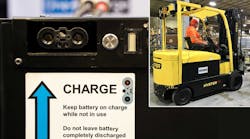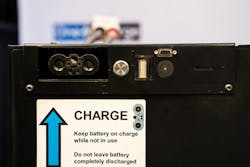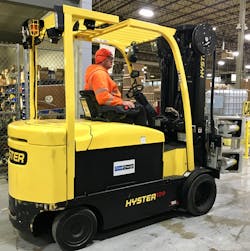What you’ll learn:
- How many CAN networks can be used by the same BMS?
- What is a CAN gateway?
- BMS features to consider.
The electronics of battery-management systems (BMS)—the “brain” of the battery— are evolving rapidly, far more so than improvements in battery cells and their chemistry. But the controller-area-network (CAN) connections between the BMS, the battery’s cells and other elements, and external devices are playing maybe the most important role. The only question is “how many do you need?”
The switch to lithium-ion (Li-ion) batteries has improved the efficiency of industrial-grade electric vehicles (EVs) such as off-highway equipment. Safety is being enhanced, too. But to bring the best out of these batteries, there must be constant, reliable communication between the power source and the EV, the charger, and other system components.
The Role of a BMS
Ideally, a BMS enhances safety and reliability in addition to extending battery life through constant optimization of the performance of individual cells and the battery pack. But what features should you consider when plotting out the design of a custom BMS or trying to buy one? Key factors include:
- Monitoring and control capabilities: A robust BMS is always equipped with these capabilities, whether it’s the ability to adjust charging rate or discharging rate, or monitoring temperature, charge, and voltage of batteries.
- Charger parameters and settings: Battery compatibility, voltage, energy throughput, charging rate, and the like are all important metrics.
- Value: Consider the BMS feature set, performance, reliability, and other relevant characteristics in assessing the cost-to-value tradeoff.
- Data capabilities: Wi-Fi and cellular connectivity are also preferable for connection to a central router and/or the cloud, remote troubleshooting and diagnostics, and data presentation in a user interface.
What is CAN?
From automotive to industrial control industries, the CAN communication protocol is common and widely used to connect systems, such as the engine control unit, transmission control unit, and steering electronics, among others.
CANs are also used in the BMS at the heart of some of the most widespread industrial EVs out there—forklifts. These networks enable the various electronic components of a forklift to communicate with the battery and relay information. Forklift battery CAN integration guarantees that the battery and the host truck or charger are working as one system and exchange all necessary data.
A BMS monitors the state of the battery on the cell and pack levels, controls power output, and optimizes the performance of individual cells. A CAN connects the BMS to all battery sensors and the forklift controls and indicators.
One of the main advantages of using CAN is that it allows for real-time communication between the various components of the truck, charger, and the battery itself. This is important for making sure that the forklift is operating safely and efficiently. For example, the BMS can monitor the state of charge (SOC) of the battery and send this information to the forklift’s control unit, which is able to adjust the power output of the forklift to ensure that it’s running at optimal performance.
Temperature and voltage—at the cell and pack level—are also relayed to the truck by a CAN-integrated battery. The BMS can use data from the battery’s internal sensors to adjust the charging rate of the battery or provide alerts to the driver if the battery is approaching a low SOC.
Moreover, CANs help improve the reliability of the battery system by adding protection from electromagnetic interference (EMI) or other noise, which tends to be elevated in EVs due to the presence of high-speed electric motors. This means better syncing of the cells and even longer lifecycles, while the lack of EMI also results in less downtime and a reduced possibility of system failure. Where productivity matters, a BMS with CAN connectivity can make a difference.
How Many CANs Can Occupy the Same BMS?
The battery-management system may use CAN to connect to a power-management block; indicators; current, temperature, and other sensors; start/stop systems; built-in chargers; battery cooling and heating systems; battery pack controls; and discharge ports for other gear.
A BMS isn’t required to have a CAN integration and communication protocol with a truck or a charger, and some don’t have any. Some batteries have a single CAN bus to connect with the truck. Others have parallel CAN connections—one to the fork truck and the other to the charger.
Advanced forklift batteries may feature multiple CAN connections as part of their BMS. For example, OneCharge developed a multi-CAN BMS that connects the battery, the truck, the charger, and all of the internal elements and components of the battery pack itself. Other connections are reserved for outside equipment, such as an outside battery discharge indicator (BDI).
Multiple CANs can also assist with data protection. For example, the charger and forklift could be on separate CAN networks to reduce interference from other components in the system.
Furthermore, two or more CAN networks can communicate with each other within a BMS using a CAN gateway. The gateway works like a bridge between two or more distinct connections.
The networks themselves translate messages from one CAN to another in a compatible format created by the system designer to form a CAN interface.
With the help of multiple CAN networks and a gateway to manage communication between those networks, various components in the EV can share information and coordinate actions in very short periods of time. In turn, it improves the dependability of the system.


